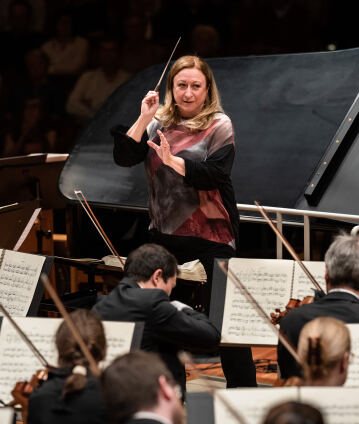Simone Young conducts Messiaen’s “Turangalîla-Symphony”

Olivier Messiaen’s monumental Turangalîla-Symphony is a paean to joy and love in all their facets, inspired by the Tristan legend. Messiaen creates his magical soundscapes with an unusual orchestra that includes an imposing percussion section, electronic sounds and a highly virtuosic piano part, interpreted here by Cédric Tiberghien. The Berliner Philharmoniker will be conducted by Simone Young.
Turangalîla – a title that opens up a whole cosmos: combining the Sanskrit words turanga (tempo) and lîla (play), it offers scope for many associations. Olivier Messiaen explained its meaning in a programme introduction: “What is meant is play in the sense of divine influence on cosmic events, i.e. the play of creation, destruction, the play of life and death. Lîla also means love. Turanga means movement and rhythm. Turangalîla therefore means all at once love song, hymn to joy, time, movement, rhythm, life and death.”
In the Turangalîla-Symphonie, completed in 1948, Messiaen fuses Asian and European mysticism and sound worlds. On the European side, he found the inspiration for his “love song” in the legend of Tristan. However, the composer ignores intrigue and betrayal, he was particularly fascinated by the idea of a fateful, all-transcending love.
Messiaen’s symphony is as free as the adaptation of the Tristan myth: the ten-movement work does not follow a programmatic plot. Instead of a fixed form, the music unfolds as a ritual becoming. Structure is provided by four core themes and three Hindu rhythms – they recur throughout the symphony. The piano and the ondes Martenot – one of the first electronic instruments – in the large orchestra play a decisive role in the music, which is at times percussively upbeat and at other times characterised by magically shimmering planes.
Simone Young conducts the work here for the first time with the Berliner Philharmoniker since its 2008 performance with Simon Rattle.
© 2023 Berlin Phil Media GmbH
Related interviews
Artists
Our recommendations
- Sir George Benjamin conducts the Berliner Philharmoniker
- Simone Young conducts Bruckner and Rihm
- David Zinman conducts Beethoven and the “Neruda Songs” by Peter Lieberson
- Simon Rattle conducts Beethoven’s Symphonies Nos. 2 and 5
- Sir Simon Rattle and the Orchestra Academy perform Mahler’s “Das Lied von der Erde”
- Simon Rattle conducts Mahler’s Third Symphony